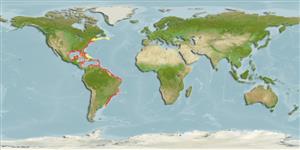>
Carangiformes (Jacks) >
Carangidae (Jacks and pompanos) > Caranginae
Etymology: Trachurus: Greek, trachys, -eia, -ys = rough + Greek, oura = tail (Ref. 45335).
Eponymy: Roy A Latham (1881–1979) of Orient, Long Island, New York, USA, was a farmer and amateur self-eductaed naturalist who collected from a very early age and continued into his late nineties! Over the years he filled the two floors and multiple rooms of [...] (Ref. 128868), visit book page.
More on author: Nichols.
Environment: milieu / climate zone / depth range / distribution range
Ekologi
marina revassocierade; djupintervall 30 - 200 m (Ref. 5951). Subtropical; 45°N - 37°S
Western Atlantic: Canada (Ref. 5951) to Maine, USA and northern Gulf of Mexico to northern Argentina; apparently rare in the West Indies.
Length at first maturity / Size / Vikt / Age
Maturity: Lm 12.0 range ? - ? cm
Max length : 40.0 cm TL hane/ej könsbestämd; (Ref. 7251); common length : 30.0 cm TL hane/ej könsbestämd; (Ref. 5217); publicerad maxvikt: 500.00 g (Ref. 5217)
Taggstrålar i ryggfenan (totalt) : 8; Mjukstrålar i ryggfenan (totalt) : 32; Taggstrålar i analfenan: 3; Mjukstrålar i analfenan: 28. Body elongate and slightly compressed; posterior edge of upper jaw reaching to below anterior margin of eye; eye large with a well developed adipose eyelid; shallow furrow on upper margin of shoulder girdle; body except for small part behind pectoral fin covered with small cycloid scales; body dark blue dorsally, silver-white ventrally; black blotch on posterior margin of opercle; tip of snout dusky; anterior margin and tip of first dorsal fin dusky, other parts pale; second dorsal fin pale; caudal fin dusky, pectoral and pelvic fins pale (Ref. 13608).
Adults are benthopelagic over continental shelves (Ref. 5217). Rare in oceanic insular areas (Ref. 5217). Juveniles associate with the jellyfish Chrysaora lactea in Southwestern Atlantic. Preyed on by juvenile comb grouper (Mycteroperca acutirostris) when protection given by the jellyfish fails (Ref. 52493). Adults are found often in schools. They feed on small invertebrates. Marketed fresh locally and considered a good food fish (Ref. 9626). In southern Brazil, stocks are found in 147 m deep water (Ref. 47377).
Life cycle and mating behavior
Könsmognad | Reproduktion | Lek | Ägg | Fecundity | Larver
Robins, C.R. and G.C. Ray, 1986. A field guide to Atlantic coast fishes of North America. Houghton Mifflin Company, Boston, U.S.A. 354 p. (Ref. 7251)
IUCN Red List Status (Ref. 130435: Version 2024-2)
Threat to humans
Harmless
Human uses
Fiskeri: kommersiell
Verktyg
Special reports
Download XML
Internet-källor
Estimates based on models
Preferred temperature (Ref.
123201): 9.5 - 27.1, mean 22.5 °C (based on 191 cells).
Phylogenetic diversity index (Ref.
82804): PD
50 = 0.5001 [Uniqueness, from 0.5 = low to 2.0 = high].
Bayesian length-weight: a=0.00955 (0.00857 - 0.01064), b=2.97 (2.94 - 3.00), in cm total length, based on LWR estimates for this species (Ref.
93245).
Trofisk nivå (Ref.
69278): 4.0 ±0.2 se; based on diet studies.
Resiliens (Ref.
120179): Mellan, lägsta populationsfördubblingstid 1,4-4,4 år (K=0.16; tm=2).
Prior r = 0.55, 95% CL = 0.36 - 0.83, Based on 1 data-limited stock assessment.
Fishing Vulnerability (Ref.
59153): Moderate vulnerability (37 of 100).
Climate Vulnerability (Ref.
125649): Low vulnerability (11 of 100).
Nutrients (Ref.
124155): Calcium = 110 [48, 194] mg/100g; Iron = 1.94 [1.02, 3.58] mg/100g; Protein = 20.1 [19.1, 20.9] %; Omega3 = 0.201 [0.116, 0.339] g/100g; Selenium = 16.6 [8.3, 34.4] μg/100g; VitaminA = 63.7 [15.9, 264.8] μg/100g; Zinc = 1.65 [1.07, 2.55] mg/100g (wet weight); based on
nutrient studies.
